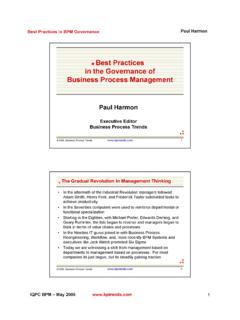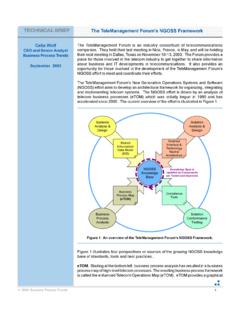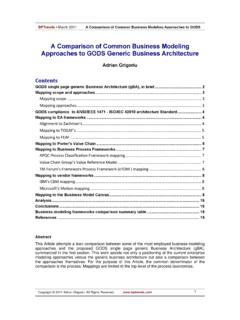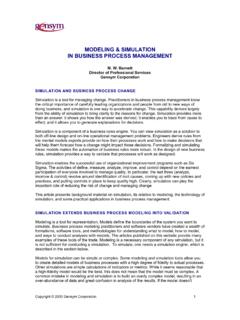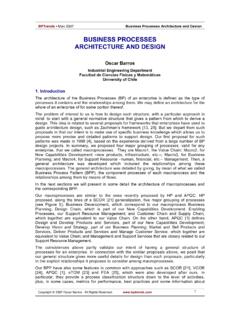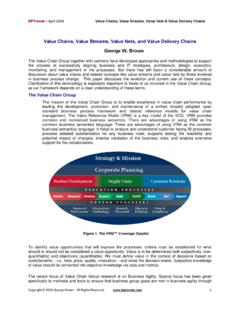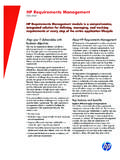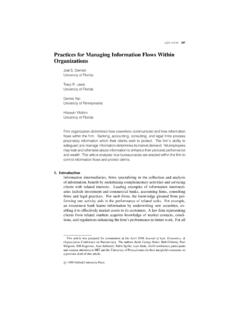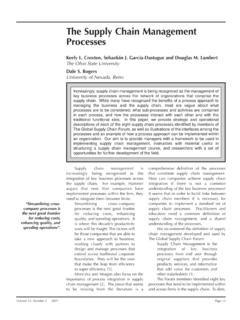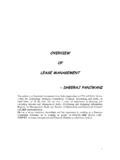Transcription of A BPT BOOK REVIEW Managing Business Process …
1 1234567890123456789012345678901212345678 9012123456789012345678901234567890121234 5678901212345678901234567890123456789012 1234567890121234567890123456789012345678 9012123456789012123456789012345678901234 5678901212345678901212345678901234567890 1234567890121234567890121234567890123456 7890123456789012123456789012345678901234 5678901212345678901234567890123456789123 4567890123456789012345678901212345678901 2345678901234567890121234567890123456789 0123456789123456789012345678901234567890 1212345678901234567890123456789012123456 7890123456789012345678912345678901234567 8901234567890121234567890123456789012345 6789012123456789012345678901234567891234 5678901234567890123456789012123456789012 3456789012345678901212345678901234567890 1234567891234567890123456789012345678901 2123456789012345678901234567890121234567 8901234567890123456789123456789012345678 9012345678901212345678901234567890123456 7890121234567890123456789012345678912345 6789012345678901234567890121234567890123 4567890123456789012123456789012345678901 23456789A BPT BOOK REVIEWM anaging Business Process Flows1 March 2004 Managing BusinessProcess FlowsRavi Anupindi, SunilChopra, Sudhakar , Jan A.
2 VanMieghem and EitanZemelPrentice Hall1999267 pagesCD Disc of ProcessModel, a modelingand simulation 2004 Business Process TrendsReviewed by Paul HarmonThis book is a basic introduction to Process analysis and improvement, asconceptualized by academic consultants resident at Northwest University'sKellogg Graduate School of Management. The focus here is on helping managersunderstand the basic concepts of processes, the measurement of Process flows ,and managerial techniques that can be used to synchronize and improve authors conceptualize this as the essence of operations management. Thebook assumes an organization producing products and spends quite a bit oftime discussing how to rationalize the production of multiple product , as the authors term the book, is divided into four major sections:I.
3 Process Management and Strategy - which introduces the basic concepts ofbusiness processes and management Process Flow Measurement - which examines key Process measures andthe relationships and management levers for controlling Process Flow Variability - which considers the effects of uncertainty in flowson Process performance and control Process Integration - which defines a set of principles for synchronizing flowsof materials and information through a network of processes to maximizeeconomic keeping with its academic background of the authors, the book is technicaland spends a lot of time with precise definitions, formulas, and , the text seems to assume advanced students, since it provides briefdefinitions and moves along rapidly.
4 If a reader didn't have a good idea of how tomodel a complex Process when he or she began this book, he or she wouldn'tobtain it by reading this book. Assuming a simple Process , however, or someprevious knowledge of modeling techniques, this book is an excellent introductionto the concepts a manager would need to do some serious simulation book comes with a disc with an educational version of the software tool,ProcessModel, which combines Micrografx FlowCharter and PROMODEL'ssimulation tool. Using this software a reader can set up and study the varioussituations suggested in the book. (Exercises are available on the Prentice Hallwebsite: )Many managers who have taken graduate courses have encountered simulationsdone with spreadsheets, or with system dynamic's models.
5 This book focuseson discrete event simulation done in the context of Business Process is not a book for the casual reader, or for someone without some familiaritywith Process analysis, a good grounding in probability and statistics, and afamiliarity with calculus. Indeed, I'd probably describe this book as a text bookfor an advanced course in Process simulation and operations analysis. That123456789012345678901234567890121234 5678901212345678901234567890123456789012 1234567890121234567890123456789012345678 9012123456789012123456789012345678901234 5678901212345678901212345678901234567890 1234567890121234567890121234567890123456 7890123456789012123456789012123456789012 3456789012345678901212345678901212345678 9012345678901234567890121234567890123456 7890123456789012123456789012345678901234 5678912345678901234567890123456789012123 4567890123456789012345678901212345678901 2345678901234567891234567890123456789012 3456789012123456789012345678901234567890 1212345678901234567890123456789123456789 0123456789012345678901212345678901234567 8901234567890121234567890123456789012345 6789123456789012345678901234567890121234 5678901234567890123456789012123456789012 3456789012345678912345678901234567890123 4567890121234567890123456789012345678901 2123456789012345678901234567891234567890 1234567890123456789012123456789012345678 9012345678901212345678901234567890123456 7891234567890123456789012345678901212345 6789012345678901234567890121234567890123 4567890123456789A BPT BOOK REVIEWM anaging Business Process Flows2 Copyright 2004 Business Process Trendssaid, I think the book offers a very systematic introduction to the conceptsunderlying the simulation of Business processes and the evaluation of the you work your way through this book, using the ProcessModel software asyou go, you will end up with a very thorough understanding of the mechanics ofprocess flows .
6 This isn't a discipline that every Business manager will want tomaster, but it is increasingly useful for mathematically inclined processes are often counter-intuitive. Without using simulation, it isoften impossible to predict what will happen when inputs change dramatically asthey often do from week to week or from month to month. Moreover, as companiesattempt to build distributed processes that incorporate subprocesses managedby other companies, analysis is only going to get more discussions with experts who are experience with simulation, one is often toldthat the problems encountered by beginners usually result from trying to simulatetoo much. MBPF, with its emphasis on techniques and analytic tools might verywell lead a new practitioner to try to do something very complex.
7 I'd emphasizethe concept of minimal simulation. Start with a few elements that describe yourprocess at the highest possible level and simulate how they interact. Don't addany subprocesses or complexities you don't have to until you are completelysatisfied that you are comfortable with the high level simulation, and then onlyadd them if you can't solve your problems without adding them. As you workthrough this book you'll find it goes a lot easier if you only focus on a very through this material would certainly be a lot easier if you had a skilledteacher to guide you. On the other hand, if you have a good math background,and you have a Process tool that includes simulation and want a book to walkyou through all the basic concepts you'll need to take advantage of your tool'ssimulation capabilities, this is probably the book to Harmon is the executive editor of Business Process Trends.
8 He can be reachedat
